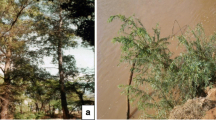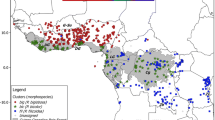Abstract
Although Populus has become the model genus for molecular genetics and genomics research on forest trees, genetic and phylogenetic relationships within this genus have not yet been comprehensively studied at the molecular level. By using 151 AFLP® (AFLP® is a registered trademark of Keygene) markers, 178 accessions belonging to 25 poplar species and three interspecific hybrids were analyzed, using three accessions belonging to two willow species as outgroups. The genetic and phylogenetic relationships were generally consistent with the known taxonomy, although notable exceptions were observed. A dendrogram as well as a single most parsimonious tree, ordered the Populus sections from the oldest Leuce to the latest Aigeiros, a pattern consistent with their known evolutionary relationships. A close relationship between Populus deltoides of the Aigeiros section and species of the Tacamahaca section was observed and, with the exception of Populus wilsonii, between the species of the Leucoides, Tacamahaca, and Aigeiros sections. Populus nigra was clearly separated from its consectional P. deltoides, and should be classified separately from P. deltoides. The AFLP profiles pointed out to the lack of divergence between some species and revealed that some accessions corresponded with interspecific hybrids. This molecular study provides useful information about genetic relationships among several Populus species and, together with morphological descriptions and crossability, it may help review and update systematic classification within the Populus genus.


Similar content being viewed by others
References
Arens P, Coops H, Jansen J, Vosman B (1998) Molecular genetic analysis of black poplar (Populus nigra L.) along Dutch rivers. Mol Ecol 7:11–18
Barrett JW, Rajora OP, Yeh FCH, Dancik BP, Strobeck C (1993) Mitochondrial DNA variation and genetic relationships of Populus species. Genome 36:87–93
Bhalerao R, Nilsson O, Sandberg G (2003) Out of the woods: forest biotechnology enters the genomic era. Curr Opin Biotechnol 14:206–213
Boerjan W (2005) Biotechnology and the domestication of forest trees. Curr Opin Biotechnol 16:159–166
Brayshaw TC (1965) The status of the black cottonwood (Populus trichocarpa Torry and Gray). Can Field Nat 79:91–95
Castiglione S, Wang G, Damiani G, Bandi C, Bisoffi S, Sala F (1993) RAPD fingerprints for identification and for taxonomic studies of elite poplar (Populus spp.) clones. Theor Appl Genet 87:54–59
Cervera M-T, Gusmão J, Steenackers M, Peleman J, Storme V, Vanden Broeck A, Van Montagu M, Boerjan W (1996) Identification of AFLP molecular markers for resistance against Melampsora larici–populina in Populus. Theor Appl Genet 93:733–737
Cervera MT, Remington D, Frigerio J-M, Storme V, Ivens B, Boerjan W, Plomion C (2000) Improved AFLP analysis of tree species. Can J For Res 30:1608–1616
Cervera M-T, Sewell MM, Faivre-Rampant P, Storme V, Van Montagu M, Boerjan W (2004) Genome mapping in Populus. In: Kumar S, Fladung M (eds) Molecular genetics and breeding of forest trees. Haworth’s Food Products Press, New York, pp 387–410
Chavarriaga-Aguirre P, Maya MM, Tohme J, Duque MC, Iglesias C, Bonierbale MW, Kresovich S, Kochert G (1999) Using microsatellites, isozymes and AFLPs to evaluate genetic diversity and redundancy in the cassava core collection and to assess the usefulness of DNA-based markers to maintain germplasm collections. Mol Breeding 5:263–273
Dayanandan S, Rajora OP, Bawa KS (1998) Isolation and characterization of microsatellites in trembling aspen (Populus tremuloides). Theor Appl Genet 96:950–956
Dellaporta SL, Wood J, Hicks JB (1983) A plant DNA minipreparation: version II. Plant Mol Biol Rep 1:19–21
Dickmann DI, Stuart KW (1983) The culture of poplars in eastern North America. Michigan State University, East Lansing
Eckenwalder JE (1977) North American cottonwoods (Populus, Salicaceae) of sections Abaso and Aigeiros. J Arnold Arboret 58:193–208
Eckenwalder JE (1984a) Natural intersectional hybridisation between North American species of Populus (Salicaceae) in sections Aigeiros and Tacamahaca. II. Taxonomy. Can J Bot 62:325–335
Eckenwalder JE (1984b) Natural intersectional hybridisation between North American species of Populus (Salicaceae) in sections Aigeiros and Tacamahaca. III. Paleobotany and evolution. Can J Bot 62:325–335
Eckenwalder JE (1996) Systematics and evolution of Populus. In: Stettler RF, Bradshaw HD Jr, Heilman PE, Hinckley TM (eds) Biology of Populus and its implications for management and conservation, Part I. NRC Research Press, National Research Council of Canada, Ottawa, pp 7–32
Faivre-Rampant P, Jeandroz S, Lefevre F, Lemoine M, Villar M, Berville A (1992) Ribosomal DNA studies in poplars: Populus deltoides, P. nigra, P. trichocarpa, P. maximowiczii, and P. alba. Genome 35:733–740
Fay MF, Lledó MD, Kornblum MM, Crespo MB (1999) From the waters of Babylon? Populus euphratica in Spain is clonal and probably introduced. Biodivers Conserv 8:769–778
Felsenstein J (1993) PHYLIP (Phylogeny Inference Package) version 3.5c. (http://evolution.genetics.washington.edu/phylip/)
Food and Agriculture Organization (1958) Poplars in forestry and land use, FAO forestry and forest products studies, No. 12. Food and Agricultural Organization, Rome
Food and Agriculture Organization (1979) Poplars and willows in wood production and land use, FAO Forestry Series, No 10. Food and Agricultural Organization, Rome, 328 pp
Hertzberg M, Aspeborg H, Schrader J, Andersson A, Erlandsson R, Blomqvist K, Bhalerao R, Uhlén M, Teeri TT, Lundeberg J, Sundberg B, Nilsson P, Sandberg G (2001) A transcriptional roadmap to wood formation. Proc Natl Acad Sci USA 98:14732–14737
Jaccard P (1908) Nouvelles recherches sur la distribution florale. Bull Soc Vaudoise Sci Natl 44:223–270
Keim P, Paige KN, Whitham TG, Lark KG (1989) Genetic analysis of an interspecific hybrid swarm of Populus: occurrence of unidirectional introgression. Genetics 123:557–565
Khasa DP, Nadeem S, Thomas B, Robertson A, Bousquet J (2003) Application of SSR markers for parentage analysis of Populus clones. Forest Gen 10:273–281
Little EL Jr (1979) Checklist of United States Trees. US Forest Service Agriculture Handbook No 541, 375 pp
Liu Z, Furnier GR (1993) Comparison of allozyme, RFLP, and RAPD markers for revealing genetic variation within and between trembling aspen and bigtooth aspen. Theor Appl Genet 87:97–105
Mougel C, Thioulouse J, Perriere G, Nesme X (2002) A mathematical method for determining genome divergence and species delination using AFLP. Int J System Evol Microbiol 52:573–586
Page RDM (1996) TREEVIEW: an application to display phylogenetic trees on personal computers. Comput Appl Biosci 12:357–358
Powell W, Morgante M, Andre C, Hanafey M, Vogel J, Tingey S, Rafalski A (1996) The comparison of RFLP, RAPD, AFLP and SSR (microsatellite) markers for germplasm analysis. Mol Breeding 2:225–238
Rahman MH, Rajora OP (2002) Microsatellite DNA fingerprinting, differentiation, and genetic relationships of clones, cultivars, and varieties of six poplar species from three sections of the genus Populus. Genome 45:1083–1094
Rahman MH, Dayanandan S, Rajora OP (2000) Microsatellite DNA markers in Populus tremuloides. Genome 43:293–297
Rajora OP (1988) Allozymes as aids for identification and differentiation of some Populus maximowiczii Henry clonal varieties. Biochem Syst Ecol 16:635–640
Rajora OP (1989a) Genetic structure and identification of Populus deltoides Marsh. clones based on allozymes. Genome 32:440–448
Rajora OP (1989b) Characterization of 43 Populus nigra L. clones representing selections, cultivars and botanical varieties based on their multilocus allozyme genotypes. Euphytica 43:197–206
Rajora OP, Dancik BP (1992) Genetic characterization and relationships of Populus alba, P. tremula, and P. × canescens, and their clones. Theor Appl Genet 84:291–298
Rajora OP, Dancik BP (1995a) Chloroplast DNA variation in Populus. II. Interspecific restriction fragment polymorphisms and genetic relationships among Populus deltoides, P. nigra, P. maximowiczii, and P. × canadensis. Theor Appl Genet 90:324–330
Rajora OP, Dancik BP (1995b) Chloroplast DNA variation in Populus. I. Intraspecific restriction fragment diversity within Populus deltoides, P. nigra and P. maximowiczii. Theor Appl Genet 90:317–323
Rajora OP, Rahman MH (2001) Microsatellite DNA markers and their usefulness in poplars, and conservation of microsatellite DNA loci in Salicaceae. In: Müller-Starck G, Schubert R (eds) Genetic response of forest systems to changing environmental conditions, forestry sciences, vol 70. Kluwer Academic Publishers, Dordrecht, pp 105–115
Rajora OP, Rahman MH (2003) Microsatellite DNA and RAPD fingerprinting, identification and genetic relationships of hybrid poplar (Populus × canadensis) cultivars. Theor Appl Genet 106:470–477
Rajora OP, Zsuffa L (1984) Interspecific crossability and its relation to the taxonomy of the genus Populus L. In: Proceedings of the joint meeting of the working parties S2-02-10 poplar provenances and S2-03-07 breeding poplar, XVII session of the international poplar commission, October 1–4, 1984. National Research Council, Ottawa, pp 33–45
Rajora OP, Zsuffa L (1989) Multilocus genetic structure, characterization and relationships of Populus × canadensis cultivars. Genome 32:99–108
Rajora OP, Zsuffa L (1990) Allozyme divergence and evolutionary relationships among Populus deltoides, P. nigra, and P. maximowiczii. Genome 33:44–49
Rajora OP, Zsuffa L (1991) Screening Populus deltoides Marsh. selections by allozymes to assure species identity. Scand J For Res 6:471–478
Rehder A (1947) Manual of cultivated trees and shrubs: Hardy in North America: exclusive of the subtropical and warmer temperate regions, 2nd edn. MacMillan, New York, pp 71–83
Rohlf FJ (1998) NTSYSpc numerical taxonomy and multivariate analysis system, version 2.0. Exeter Publishing, Setauket
Smith RL (1988) Phylogenetics of Populus L. (Salicaceae) based on restriction site fragment analysis of cDNA. MSc Thesis, University of Wisconsin, Madison
Smith RL, Sytsma KJ (1990) Evolution of Populus nigra (sect. Aigeiros): introgressive hybridization and the chloroplast contribution of Populus alba (sect. Populus). Am J Bot 77:1176–1187
Sneath PHA, Sokal RR (1973) Numeral taxonomy: principles and practice of numerical classification. WH Freeman, San Francisco, CA
Stout AB (1929) The clone in plant life. J NY Bot Garden 30:25–37
Tuskan GA, Francis KE, Russ SL, Romme WH, Turner MG (1996) RAPD markers reveal diversity within and among clonal and seedling stand of aspen in Yellowstone National Park, USA. Can J For Res 26:2088–2098
Vos P, Hogers R, Bleeker M, Reijans M, van de Lee T, Hornes M, Frijters A, Pot J, Peleman J, Kuiper M, Zabeau M (1995) AFLP: a new technique for DNA fingerprinting. Nucleic Acids Res 23:4407–4414
Willing RR, Pryor LD (1976) Interspecific hybridization in poplar. Theor Appl Genet 47:141–151
Winfield MO, Arnold GM, Cooper F, Le Ray M, White J, Karp A, Edwards KJ (1998) A study of genetic diversity in Populus nigra subsp. betulifolia in the Upper Severn area of the UK using AFLP markers. Mol Ecol 7:3–10
Wullschleger SD, Jansson S, Taylor G (2002) Genomics and forest biology: Populus emerges as the perennial favorite. Plant Cell 14:2651–2655
Zsuffa L (1975) A summary review of interspecific breeding in the genus Populus L. In: Proceedings of the 14th meeting of the Canadian tree improvement association, part 2. Canadian Forestry Service, Ottawa, pp 107–123
Acknowledgments
The authors wish to thank Marijke Steenackers, Boudewijn Michiels, An Vanden Broeck and Jos Van Slycken (Institute for Forestry and Game Management, Geraardsbergen, Belgium), Patricia Faivre-Rampant and Marc Villar (Station d’Amélioration des Arbres Forestiers, Ardon, France), Stefano Bisoffi (Istituto di Sperimentazione per la Pioppicoltura, Casale Monferrato, Italy), Eduardo Notivol (Servicio de Investigación Agraria de Aragón, Zaragoza, Spain), Gerry Douglas (Teagasc, Dublin, Ireland), Dirk Demeyere (Nationale Plantentuin van België, Meise, Belgium), Johan Possemiers (Arboretum Kalmthout, Kalmthout, Belgium), Christa Maes (Hof ter Saksen, Beveren, Belgium), Toby Bradshaw (University of Washington, Seattle, USA), Karl Gebhardt (Hessische Landesanstalt für Forsteinrichtung, Waldökologie und Waldforschung, Hann. Münden, Germany), and Luis Herrera-Estrella (Centro de Investigación y de Estudios Avanzados del Instituto Politécnico Nacional, México D.F., México) for providing plant material and advice on genotypes to be analyzed, Carlos Malpica for his valuable comments on the manuscript, and Martine De Cock for help in preparing it. This work was supported by grants from the Flemish Government (BNO/BB/6/1994,1995), the Commission of the European Communities programs (AIR1-CT92-0349 and BIO4CT96-076), and, in part, by an NSERC Discovery Grant (RGPIN0170651) to O.P.R. This research represents publication FGB0016 from the Forest Genetics and Biotechnology Group (Dalhousie University) and Canada Research Chair in Forest and Conservation Genomics and Biotechnology (University of New Brunswick). M.-T.C. is indebted to the European Union for an individual fellowship from the Human Capital Mobility program (41AS8694).
Author information
Authors and Affiliations
Corresponding author
Additional information
Communicated by D. B. Neale
Electronic supplementary material
Rights and permissions
About this article
Cite this article
Cervera, M.T., Storme, V., Soto, A. et al. Intraspecific and interspecific genetic and phylogenetic relationships in the genus Populus based on AFLP markers. Theor Appl Genet 111, 1440–1456 (2005). https://doi.org/10.1007/s00122-005-0076-2
Received:
Accepted:
Published:
Issue Date:
DOI: https://doi.org/10.1007/s00122-005-0076-2




